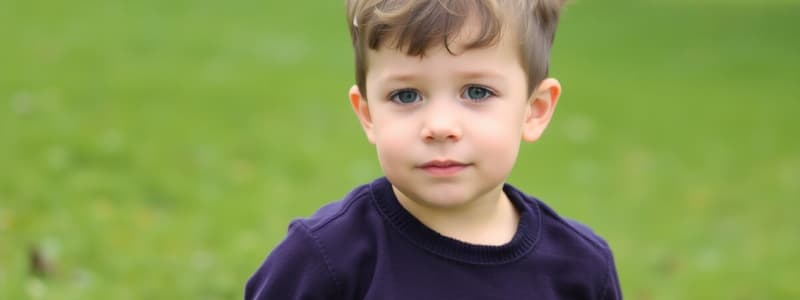Podcast
Questions and Answers
Which attachment pattern is characterized by infants seeking contact with the parent upon their return after separation?
Which attachment pattern is characterized by infants seeking contact with the parent upon their return after separation?
- Secure attachment (correct)
- Resistant attachment
- Avoidant attachment
- Disorganized attachment
What behavior is typical of infants with avoidant attachment during reunion with the parent?
What behavior is typical of infants with avoidant attachment during reunion with the parent?
- They display angry behavior towards the parent.
- They respond similarly to both the parent and stranger. (correct)
- They cling to the parent and show signs of distress.
- They attempt to communicate their feelings of insecurity.
Which attachment pattern is associated with the greatest insecurity in infants?
Which attachment pattern is associated with the greatest insecurity in infants?
- Secure attachment
- Avoidant attachment
- Resistant attachment
- Disorganized/disoriented attachment (correct)
What indicates a resistant attachment pattern in infants during reunion with their parent?
What indicates a resistant attachment pattern in infants during reunion with their parent?
During the Strange Situation, how might a disorganized/disoriented infant respond when reunited with their parent?
During the Strange Situation, how might a disorganized/disoriented infant respond when reunited with their parent?
What emotional difficulties are commonly observed in infants who have not formed a bond with a caregiver?
What emotional difficulties are commonly observed in infants who have not formed a bond with a caregiver?
What is a significant consequence for adopted children who spent time in deprived environments like Romanian orphanages?
What is a significant consequence for adopted children who spent time in deprived environments like Romanian orphanages?
Which caregiving style is most associated with insecure attachment in infants?
Which caregiving style is most associated with insecure attachment in infants?
What does interactional synchrony refer to in the context of caregiver-infant relationships?
What does interactional synchrony refer to in the context of caregiver-infant relationships?
How does sensitive caregiving contribute to attachment security?
How does sensitive caregiving contribute to attachment security?
What aspect of caregiving shows cultural variation concerning attachment security?
What aspect of caregiving shows cultural variation concerning attachment security?
What characteristic is commonly found in securely attached infants?
What characteristic is commonly found in securely attached infants?
Which of the following statements correctly describes insecure infants?
Which of the following statements correctly describes insecure infants?
What is the primary purpose of the internal working model in attachment theory?
What is the primary purpose of the internal working model in attachment theory?
During which phase do infants begin to show understanding of the goals and intentions of their attachment figures?
During which phase do infants begin to show understanding of the goals and intentions of their attachment figures?
In what situation might a securely attached infant exhibit exploratory behavior?
In what situation might a securely attached infant exhibit exploratory behavior?
What does Mary Ainsworth's Strange Situation procedure aim to measure?
What does Mary Ainsworth's Strange Situation procedure aim to measure?
What factor is primarily responsible for the decline in separation protest in infants?
What factor is primarily responsible for the decline in separation protest in infants?
How does the security of an attachment influence an infant's future relationships?
How does the security of an attachment influence an infant's future relationships?
What is a significant characteristic of infants in Bowlby's phase 4 of attachment?
What is a significant characteristic of infants in Bowlby's phase 4 of attachment?
Which statement is true regarding the quality of infants' attachment experiences?
Which statement is true regarding the quality of infants' attachment experiences?
Flashcards
Institutionalized infant attachment
Institutionalized infant attachment
Infants in institutions, lacking consistent adult interaction, experience emotional difficulties and attachment problems.
Attachment difficulties
Attachment difficulties
Problems in forming healthy emotional bonds with primary caregivers, leading to various emotional and mental health issues.
Sensitive caregiving
Sensitive caregiving
Prompt, consistent, and appropriate responses to infant signals, leading to secure attachment.
Insecure attachment
Insecure attachment
Signup and view all the flashcards
Interactional synchrony
Interactional synchrony
Signup and view all the flashcards
Secure attachment
Secure attachment
Signup and view all the flashcards
Quality of caregiving
Quality of caregiving
Signup and view all the flashcards
Neurophysiological effects of orphanage care
Neurophysiological effects of orphanage care
Signup and view all the flashcards
Avoidant Attachment
Avoidant Attachment
Signup and view all the flashcards
Resistant Attachment
Resistant Attachment
Signup and view all the flashcards
Disorganized/Disoriented Attachment
Disorganized/Disoriented Attachment
Signup and view all the flashcards
Strange Situation Procedure
Strange Situation Procedure
Signup and view all the flashcards
Separation Protest
Separation Protest
Signup and view all the flashcards
Internal Working Model
Internal Working Model
Signup and view all the flashcards
Attachment Security
Attachment Security
Signup and view all the flashcards
Strange Situation
Strange Situation
Signup and view all the flashcards
Secure Base
Secure Base
Signup and view all the flashcards
Individual Differences in Attachment
Individual Differences in Attachment
Signup and view all the flashcards
Attachment figure
Attachment figure
Signup and view all the flashcards
Ethological Theory of Attachment
Ethological Theory of Attachment
Signup and view all the flashcards
Study Notes
Child Psychology: Pre-School
- Changing Demographics: Family structures are diverse, with more single parents. Case studies highlight severe early deprivation, including prolonged neglect, abuse, and institutionalization.
- Reactive Attachment Disorder (RAD): RAD is characterized by a child's failure to form healthy emotional bonds with caregivers, often due to emotional neglect or abuse.
- Temperament: Individual differences in behavioral styles, emotions, and characteristic ways of responding. Temperament is linked to how quickly emotions are shown, their intensity, duration, and fading speed. Inhibition demonstrates significant stability from infancy through early childhood (e.g., Kagan's research).
- Chess and Thomas' Classification: Three basic temperament types:
- Easy child: generally positive, regular routines, easily adapts to change.
- Difficult child: negative reactions, irregular routines, slow to accept change.
- Slow-to-warm-up child: low activity level, somewhat negative, slow to adapt.
- Kagan's Behavioral Inhibition: Categorization of temperment based on shyness or boldness when exposed to the unfamiliar. Shy children/inhibited temperament react cautiously or fearfully to novel situations.
- Rothbart and Bates' Classification: Three broad dimensions of temperament:
- Extraversion/surgency: positive anticipation, impulsivity, activity level, sensation seeking.
- Negative affectivity: fear, frustration, sadness, discomfort.
- Effortful control: flexibility in attention, impulse control, and perceptual sensitivity. Infants high in effortful control are better at regulating their arousal and have soothing strategies.
- Goodness-of-Fit Model: Compatibility between a child's temperament and environmental demands. A good fit leads to positive outcomes; a poor fit can lead to adjustment problems.
- Parenting Styles: Specific approaches to child-rearing are connected to particular temperaments
- Shy children: benefit from encouragement to explore.
- Aggressive/difficult children: firm, consistent discipline.
- Fearful children: warmth and gentle discipline.
- Attachment: Close emotional bond between two people, developed especially during infancy.
- Ethological Theory: Bowlby's theory emphasizing the importance of attachment in the first year and responsiveness of the caregiver.
- Phases of Attachment:
- Pre-attachment (0-2 months): Infants display innate signals to summon caregivers.
- Attachment in the making (2-7 months): Preference for familiar caregivers develops.
- Clear-cut attachment (7-24 months): Specific attachments develop with separation anxiety.
- Reciprocal Relationships (24+ months): Children consider others' feelings and adjust behavior accordingly
- Internal Working Model: Expectations about attachment figures, influencing future relationships.
- Strange Situation: Ainsworth's observational measure for assessing infant attachment styles, involving a series of separations and reunions with the caregiver.
- Attachment Patterns: Secure, avoidant, resistant, and disorganized/disoriented.
Opportunity and Quality of Caregiving
- Research highlights the importance of sensitive caregiving.
- Insecure attachments can result from inconsistent or unresponsive caregiving.
- Good caregiving involves a sensitive response to signals, pacing, and encouraging interaction.
Studying That Suits You
Use AI to generate personalized quizzes and flashcards to suit your learning preferences.




